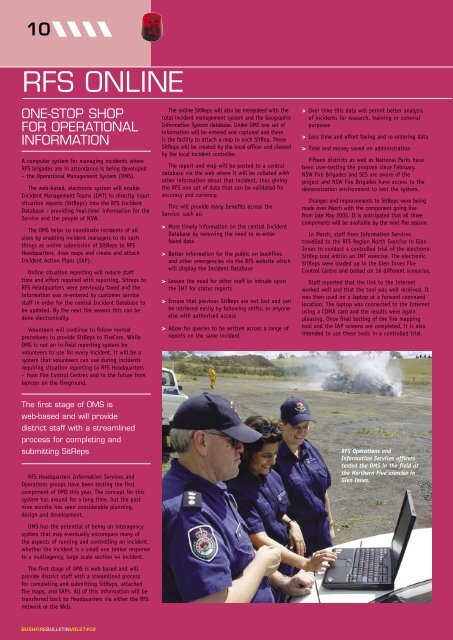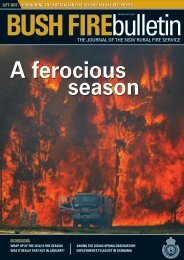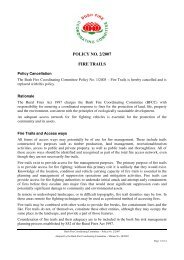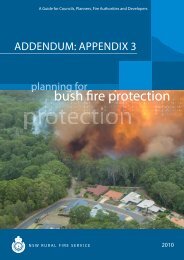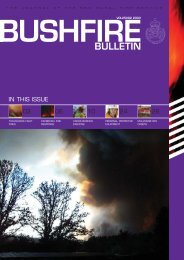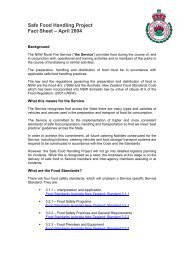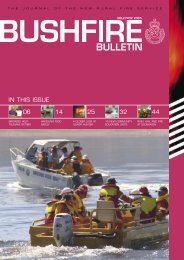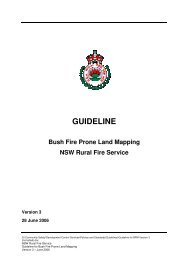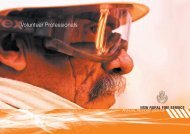to view - NSW Rural Fire Service
to view - NSW Rural Fire Service
to view - NSW Rural Fire Service
You also want an ePaper? Increase the reach of your titles
YUMPU automatically turns print PDFs into web optimized ePapers that Google loves.
10<br />
RFS ONLINE<br />
ONE-STOP SHOP<br />
FOR OPERATIONAL<br />
INFORMATION<br />
A computer system for managing incidents where<br />
RFS brigades are in attendance is being developed<br />
– the Operational Management System (OMS).<br />
The web-based, electronic system will enable<br />
Incident Management Teams (IMT) <strong>to</strong> directly input<br />
situation reports (SitReps) in<strong>to</strong> the RFS Incident<br />
Database – providing ‘real-time’ information for the<br />
<strong>Service</strong> and the people of <strong>NSW</strong>.<br />
The OMS helps <strong>to</strong> coordinate incidents of all<br />
sizes by enabling incident managers <strong>to</strong> do such<br />
things as online submission of SitReps <strong>to</strong> RFS<br />
Headquarters, draw maps and create and attach<br />
Incident Action Plans (IAP).<br />
Online situation reporting will reduce staff<br />
time and effort required with reporting. Sitreps <strong>to</strong><br />
RFS Headquarters were previously faxed and the<br />
information was re-entered by cus<strong>to</strong>mer service<br />
staff in order for the central Incident Database <strong>to</strong><br />
be updated. By the next fire season this can be<br />
done electronically.<br />
Volunteers will continue <strong>to</strong> follow normal<br />
procedures <strong>to</strong> provide SitReps <strong>to</strong> <strong>Fire</strong>Com. While<br />
OMS is not an in-field reporting system for<br />
volunteers <strong>to</strong> use for every incident, it will be a<br />
system that volunteers can use during incidents<br />
requiring situation reporting <strong>to</strong> RFS Headquarters<br />
– from <strong>Fire</strong> Control Centres and in the future from<br />
lap<strong>to</strong>ps on the fireground.<br />
The online SitReps will also be integrated with the<br />
<strong>to</strong>tal incident management system and the Geographic<br />
Information System database. Under OMS one set of<br />
information will be entered and captured and there<br />
is the facility <strong>to</strong> attach a map <strong>to</strong> each SitRep. These<br />
SitReps will be created by the local officer and cleared<br />
by the local incident controller.<br />
The report and map will be posted <strong>to</strong> a central<br />
database via the web where it will be collated with<br />
other information about that incident, thus giving<br />
the RFS one set of data that can be validated for<br />
accuracy and currency.<br />
This will provide many benefits across the<br />
<strong>Service</strong>, such as:<br />
> More timely information on the central Incident<br />
Database by removing the need <strong>to</strong> re-enter<br />
faxed data<br />
> Better information for the public on bushfires<br />
and other emergencies via the RFS website which<br />
will display the Incident Database<br />
> Lessen the need for other staff <strong>to</strong> intrude upon<br />
the IMT for status reports<br />
> Ensure that previous SitReps are not lost and can<br />
be retrieved easily by following shifts, or anyone<br />
else with authorised access<br />
> Allow for queries <strong>to</strong> be written across a range of<br />
reports on the same incident<br />
> Over time this data will permit better analysis<br />
of incidents for research, training or coronial<br />
purposes<br />
> Less time and effort faxing and re-entering data<br />
> Time and money saved on administration<br />
Fifteen districts as well as National Parks have<br />
been user-testing the program since February.<br />
<strong>NSW</strong> <strong>Fire</strong> Brigades and SES are aware of the<br />
project and <strong>NSW</strong> <strong>Fire</strong> Brigades have access <strong>to</strong> the<br />
demonstration environment <strong>to</strong> test the system.<br />
Changes and improvements <strong>to</strong> SitReps were being<br />
made over March with the component going live<br />
from late May 2005. It is anticipated that all three<br />
components will be available by the next fire season.<br />
In March, staff from Information <strong>Service</strong>s<br />
travelled <strong>to</strong> the RFS Region North Exercise in Glen<br />
Innes <strong>to</strong> conduct a controlled trial of the electronic<br />
SitRep <strong>to</strong>ol within an IMT exercise. The electronic<br />
SitReps were loaded up in the Glen Innes <strong>Fire</strong><br />
Control Centre and tested on 16 different scenarios.<br />
Staff reported that the link <strong>to</strong> the Internet<br />
worked well and that the <strong>to</strong>ol was well received. It<br />
was then used on a lap<strong>to</strong>p at a forward command<br />
location. The lap<strong>to</strong>p was connected <strong>to</strong> the Internet<br />
using a CDMA card and the results were again<br />
pleasing. Once final testing of the fire mapping<br />
<strong>to</strong>ol and the IAP screens are completed, it is also<br />
intended <strong>to</strong> use these <strong>to</strong>ols in a controlled trial.<br />
The first stage of OMS is<br />
web-based and will provide<br />
district staff with a streamlined<br />
process for completing and<br />
submitting SitReps<br />
RFS Headquarters Information <strong>Service</strong>s and<br />
Operations groups have been testing the first<br />
component of OMS this year. The concept for this<br />
system has around for a long time, but the past<br />
nine months has seen considerable planning,<br />
design and development.<br />
OMS has the potential of being an interagency<br />
system that may eventually encompass many of<br />
the aspects of running and controlling an incident,<br />
whether the incident is a small one tanker response<br />
<strong>to</strong> a multiagency, large scale section 44 incident.<br />
The first stage of OMS is web-based and will<br />
provide district staff with a streamlined process<br />
for completing and submitting SitReps, attached<br />
fire maps, and IAPs. All of this information will be<br />
transferred back <strong>to</strong> Headquarters via either the RFS<br />
network or the Web.<br />
RFS Operations and<br />
Information <strong>Service</strong>s officers<br />
tested the OMS in the field at<br />
the Northern Five exercise in<br />
Glen Innes.<br />
BUSHFIREBULLETINVOL27#02


